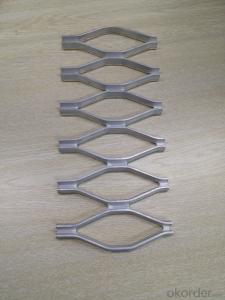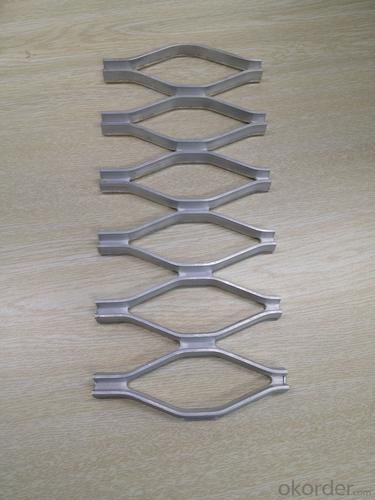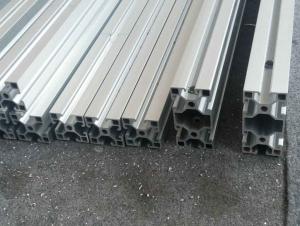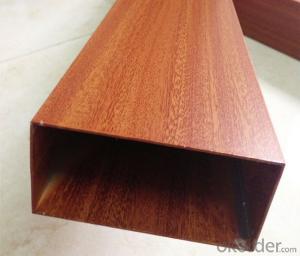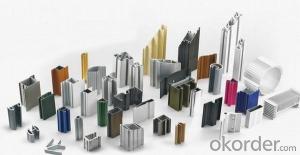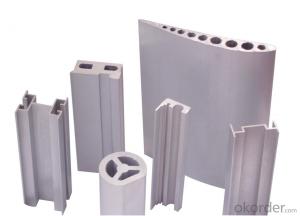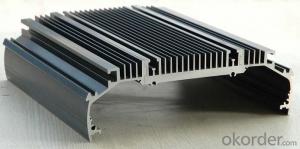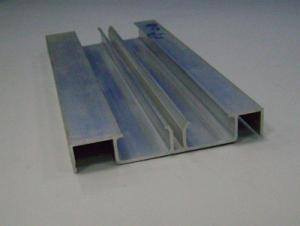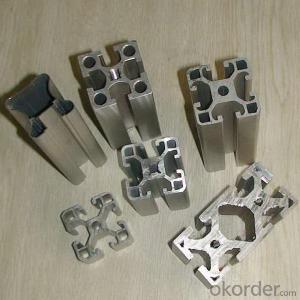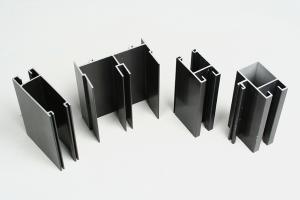Aluminum Extrusion Profiles Protective Screening
OKorder Service Pledge
OKorder Financial Service
You Might Also Like
We are the largest aluminum profilemanufacture in
The detail descriptions of aluminum profile as bellowing:
Alloy Aluminum 6063,6061,6005,6082 or customer nominated | |
Temper | T3, T4, T5, T6 and other |
Surface | Anodize, electrophoresis, powder coating, PVDF coating, etc. |
Colour | Any colour based on Standard Germany RAL Mark |
Length | Not more than 16 meters |
Good Package | Inner plastic film /outside carton/wooden pallets |
Payment Method | T/T, L/C, etc |
Delivery Time | Normally 2-4 weeks, Delivery time can be consulted. |
Press Machine | 500-12500 tons all together 93 press lines. |
Fabrication | 1. Windows and doors; 2. Drilling; 3. Bending; 4. Cutting; 5. etc. |
Certificate | ISO/TS 16949,DNV,IRIS,CCS,AFA,etc. |
Dies | 1. Using our dies, no fee; |
2. Using customer drawing, opening dies, usually about 5~50 tons then the dies cost can be refunded. | |
3. Die cost is negotiable base on the order quantity | |
Capability | Annual output 800,000 tons |
- Q: This question asks for methods to reduce waste associated with the production and utilization of aluminum profiles in the construction industry.
- <p>To minimize waste during the production and use of aluminum profiles in construction, one can adopt several strategies: 1. Optimize production processes to reduce material waste by using precision cutting and advanced manufacturing techniques. 2. Implement recycling programs to repurpose scrap aluminum, reducing the need for raw material extraction. 3. Design buildings with modular aluminum components that can be easily disassembled and reused in future projects. 4. Educate construction workers on proper handling and storage to prevent damage and waste. 5. Use computer-aided design (CAD) to accurately plan material requirements, minimizing offcuts. 6. Choose sustainable aluminum sources and suppliers that prioritize waste reduction. 7. Regularly audit and update production methods to incorporate new waste reduction technologies and practices.</p>
- Q: The user is asking for methods to prevent aluminum profiles from warping or twisting while being installed.
- <p>To avoid warping or twisting of aluminum profiles during installation, ensure proper handling and support. Use sturdy brackets and supports to maintain alignment and prevent bending. Keep the profiles clean and free of debris that could cause uneven pressure. Avoid overtightening fasteners, which can cause stress and deformation. Use the correct tools and techniques for cutting and drilling to avoid damage. Maintain a consistent temperature and humidity during the installation process, as extreme conditions can affect the material's stability. Finally, inspect the profiles regularly for any signs of warping or twisting and address issues promptly.</p>
- Q: This question asks for a method to determine the quantity of aluminum profiles required for a specific project.
- <p>To calculate the amount of aluminum profiles needed for a project, first, determine the dimensions and design of the structure. Measure the length, width, and height of the required profiles. Consider the number of profiles needed for each section of the project. Multiply the length of each profile by the number of profiles required. Sum these totals for all sections to get the overall amount of aluminum needed. Factor in a margin for cutting and waste to ensure you have enough material. Consult with suppliers or use specialized software for more precise calculations, especially for complex projects.</p>
- Q: Are aluminum profiles suitable for use in medical device manufacturing?
- Yes, aluminum profiles are suitable for use in medical device manufacturing. Aluminum is a lightweight and durable material that offers excellent mechanical properties, corrosion resistance, and versatility. It can be easily machined and formed into various shapes, making it ideal for creating custom components for medical devices. Additionally, aluminum profiles can be anodized or coated to further enhance their surface properties, ensuring compatibility with medical environments.
- Q: This question asks for an explanation of the various methods employed in the manufacturing of aluminum profiles.
- <p>Aluminum profiles are produced using several manufacturing processes, each suited to different applications and profile shapes. The primary methods include: Casting, where molten aluminum is poured into molds to form profiles; Extrusion, the most common process, where aluminum is pushed through a die to create long, continuous shapes; Rolling, used for creating flat or curved sheets and plates; Forging, which involves shaping aluminum by applying compressive forces; and Machining, where aluminum profiles are cut and shaped using tools. Each process has its advantages and is chosen based on the desired profile's complexity, strength, and cost-effectiveness.</p>
- Q: Are aluminum profiles fire-resistant?
- No, aluminum profiles are not inherently fire-resistant. They have a low melting point and can conduct heat, which means they can contribute to the spread of fire. However, aluminum profiles can be enhanced with fire-resistant coatings or used in fire-rated assemblies to improve their fire performance.
- Q: What are the different color options for aluminum profiles?
- Aluminum profiles come in a variety of color options, catering to different aesthetic preferences and functional needs. Here are some commonly chosen colors: 1. Natural aluminum: This option emphasizes the raw and metallic look of aluminum, giving it a sleek, modern, and minimalist appeal. 2. Anodized finishes: By undergoing an electrochemical process called anodizing, aluminum develops a protective layer that enhances its durability and resistance to corrosion. Anodizing also offers a wide range of color choices, including black, bronze, gold, silver, as well as vibrant shades of blue, red, green, and other colors. 3. Powder coating: Another popular method for coloring aluminum profiles involves applying a dry powder to the surface, which is then cured under heat to create a durable and visually appealing finish. Powder coating provides a vast selection of colors, including standard options, metallic finishes, and special effects like textures and patterns. 4. Painted finishes: Liquid coatings can be used to paint aluminum profiles, allowing for a broader spectrum of colors that can be customized to match specific design requirements. Painted finishes offer versatility and can be applied with different gloss levels, such as matte, satin, or high gloss. 5. Wood grain finishes: For those seeking a wood-like appearance without the maintenance that comes with actual wood, aluminum profiles can be finished with a wood grain pattern. This option combines the durability of aluminum with the warm and natural look of wood, providing a wide range of wood species and finishes. Ultimately, the choice of color for aluminum profiles depends on personal preference, architectural style, desired durability, and the overall design concept.
- Q: Can aluminum profiles be recycled indefinitely?
- Yes, aluminum profiles can be recycled indefinitely. Unlike other materials, aluminum does not degrade during the recycling process. It can be melted down and reshaped into new profiles without losing its inherent properties. This essentially means that aluminum profiles have a never-ending life cycle. Recycling aluminum requires significantly less energy and resources compared to producing new aluminum, making it an environmentally sustainable option. Moreover, the recycling process can be repeated countless times without any loss in quality, making aluminum one of the most recycled materials in the world.
- Q: Can aluminum profiles be used for creating lighting fixtures?
- Yes, aluminum profiles can be used for creating lighting fixtures. Aluminum is a versatile material that is lightweight, durable, and has excellent thermal conductivity, making it suitable for dissipating heat generated by lighting components. Additionally, aluminum profiles can be easily shaped, allowing for various designs and forms of lighting fixtures.
- Q: What are the different packaging and shipping considerations for aluminum profiles?
- When dealing with the packaging and shipping of aluminum profiles, there are various factors to take into account. To begin with, it is important to use packaging materials that are sturdy and strong enough to protect the profiles from any external damage during transit. This may involve the use of materials such as corrugated cardboard boxes or wooden crates. Another significant consideration is the need for proper padding and cushioning inside the packaging to prevent any movement or shifting of the profiles. This can be achieved by utilizing protective packaging materials like foam inserts, bubble wrap, or packing peanuts. These materials serve to absorb shock and provide a layer of protection against impacts or vibrations that may occur during transportation. Furthermore, it is crucial to ensure that the packaging is securely sealed and fastened to avoid any accidental opening or harm to the profiles. This can be accomplished by using strong adhesive tapes or strapping materials to maintain the integrity of the packaging. The size and weight of the aluminum profiles should also be taken into consideration when selecting the appropriate packaging. Larger or heavier profiles may necessitate the use of custom-made crates or pallets to facilitate safe and efficient transportation. It is imperative to ensure that the packaging is specifically designed to handle the weight and dimensions of the profiles in order to prevent any structural damage. Moreover, it is essential to properly label and mark the packages to ensure their correct handling and identification during shipping. This includes clearly indicating fragile or delicate items, providing handling instructions, and marking the packages with necessary shipping information such as the destination address, contact details, and any specific instructions for the carrier. Lastly, it is vital to choose a reliable and experienced shipping carrier or logistics provider who specializes in handling aluminum profiles. They should possess the necessary expertise and equipment to safely and efficiently handle and transport these delicate products. In conclusion, considering the appropriate packaging materials, cushioning, sealing, labeling, and selecting a dependable shipping partner are crucial factors to consider when packaging and shipping aluminum profiles. This will ensure the secure delivery of the profiles to their intended destination.
Send your message to us
Aluminum Extrusion Profiles Protective Screening
OKorder Service Pledge
OKorder Financial Service
Similar products
Hot products
Hot Searches
Related keywords
